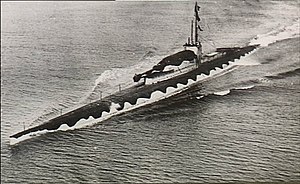HMS M1 (1917)
 HMS M1, painted in a camouflage pattern.
| |
| History | |
|---|---|
| Name | HMS M1 |
| Launched | 9 July 1917 |
| Homeport | Portsmouth |
| Fate | Sunk in collision, 12 November 1925 |
| General characteristics | |
| Class and type | M-class submarine |
| Displacement |
|
| Length | 295 ft 9 in (90.14 m) |
| Beam | 24 ft 8 in (7.52 m) |
| Installed power |
|
| Propulsion |
|
| Speed |
|
| Range |
|
| Endurance | 80 nmi (92 mi; 150 km) at 2 kn (2.3 mph; 3.7 km/h) |
| Test depth | 200 ft (61 m) |
| Complement | 62 |
| Armament |
|
HMS M1 was a submarine of the British Royal Navy, one of four vessels of her class ordered towards the end of the First World War. She sank with the loss of her entire crew in 1925.
The vessels were originally intended as "submarine monitors", but their purpose had been changed before detailed design began. M1 was fitted with a 12-inch (305mm) gun which was intended for use against surface ships in preference to torpedoes, the argument being that, "No case is known of a ship-of-war being torpedoed when under way at a range outside of 1000 yards [915 meters]."[1]

Although the gun had an effective range of 15,000 yards (13,700 m), it was normally fired using a simple bead sight at periscope depth with only the barrel above the water. It was important for the submarine's gun to sink or disable the target with the first shot, because the gun could only be loaded on the surface.
She was 295 feet 9 inches (90.14 m) long, displaced 1,950 long tons (1,980 t) submerged and operated out of Portsmouth. She was launched on 9 July 1917, but was not involved in active service in the First World War.
In 1923, water leaking into the barrel of the gun resulted in extensive damage to the muzzle when it was fired.[2]
She sank with all 69 hands in 70 metres (230 ft) of water on 12 November 1925 while on an exercise in the English Channel when a Swedish ship, SS Vidar, struck her while she was submerged. The collision tore the gun from the hull and water flooded the interior through the open loading hole. The crew members appear to have tried to escape by flooding the interior and opening the escape hatch, but their bodies were never found.
A diving team led by Innes McCartney discovered her wreck in 1999 at a depth of 73 metres (240 ft). Later that year, Richard Larn and a BBC TV documentary crew visited the wreck, and the resulting film was broadcast in March 2000. The wreck is designated as a "protected place" under the Protection of Military Remains Act 1986.
Citations
[edit]- ^ Brown 2003, p. 131.
- ^ Tall & Kemp 1996, p. 59.
References
[edit]- Brown, D.K. (2003). The Grand Fleet: Warship Design and Development 1906-1922. London: Caxton Editions. p. 208. ISBN 1-84067-531-4.
- McCartney, Innes (2002). Lost patrols : submarine wrecks of the English Channel. Penzance: Periscope. ISBN 978-1-90438-104-4.
- Tall, J.J; Kemp, Paul (1996). HM Submarines in Camera; An Illustrated History of British Submarines. Sutton Publishing. ISBN 0-7509-0875-0.
External links
[edit]- SI 2008/0950 Designation under the Protection of Military Remains Act
- RN Subs 1916 - 1932: M Class
- British M-class submarines
- Ships built in Barrow-in-Furness
- 1917 ships
- World War I submarines of the United Kingdom
- Maritime incidents in 1925
- British submarine accidents
- Shipwrecks in the English Channel
- Protected wrecks of the United Kingdom
- Submarines sunk in collisions
- Warships lost with all hands
- 1925 disasters in the United Kingdom
